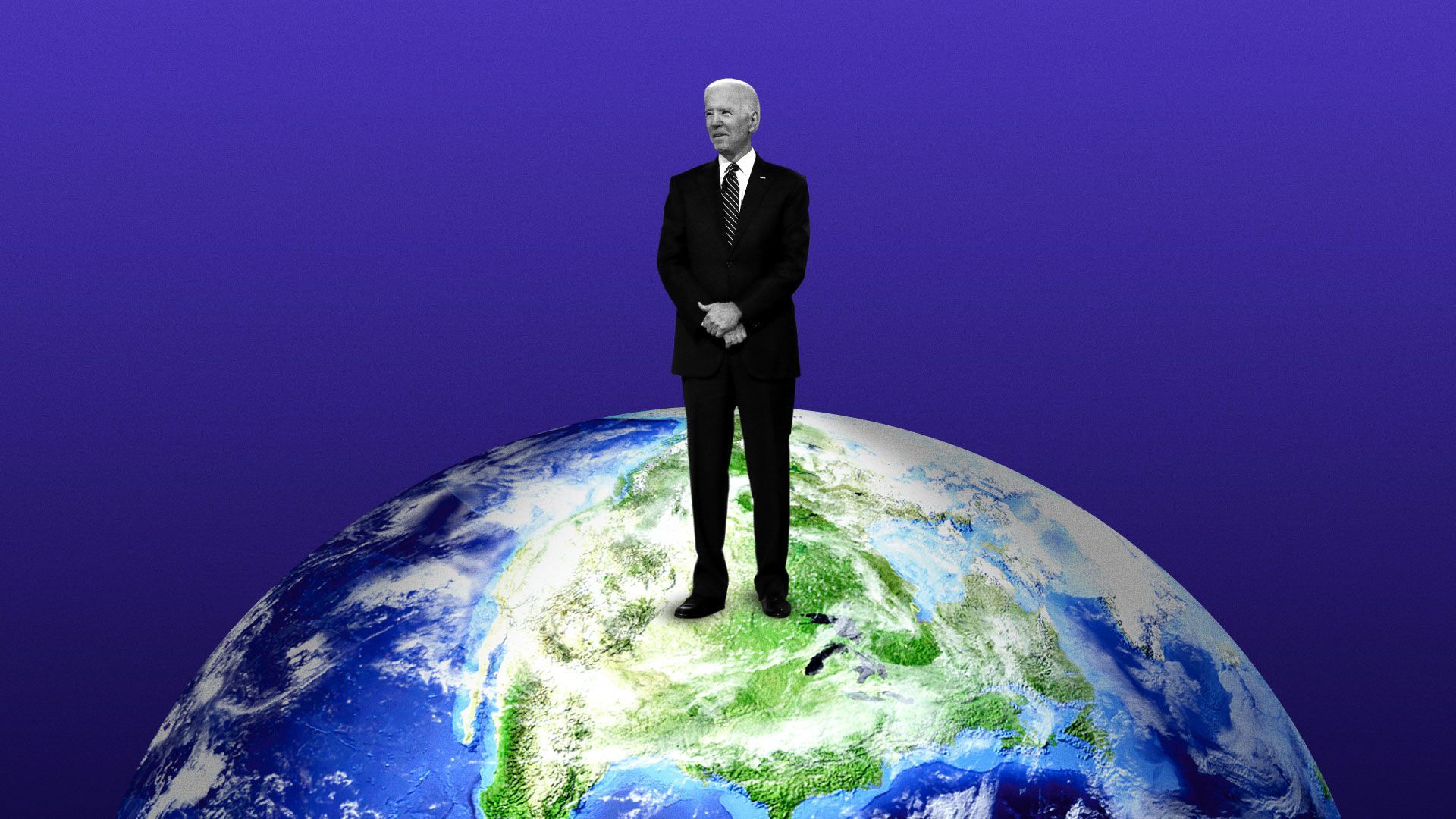| | | | | | | Presented By General Motors | | | | Generate | | By Ben Geman ·Dec 16, 2020 | | Good morning, readers! There's a lot happening, so we're a little longer than usual today. But the Smart Brevity count is still just 1,465 words, a 5.5-minute read. 🎸And happy birthday to guitar genius Billy Gibbons of ZZ Top (a favorite of Axios' @DavidNather), who have today's intro tune... | | | | | | 1 big thing: Making sense of Biden's climate and energy picks |  | | | Photo illustration: Eniola Odetunde/Axios. Photo: Spencer Platt/Getty Images | | | | The incoming Joe Biden administration just filled in some of the biggest blanks on its energy and climate team, and the decisions say plenty about its approach. Catch up fast: Obama-era EPA boss Gina McCarthy is slated to be named Biden's White House domestic climate policy adviser to lead a government-wide policy push. - Ali Zaidi, a top New York State energy and climate official, is expected to be named her deputy. Neither role requires Senate confirmation.
- Biden is expected to nominate former Michigan Gov. Jennifer Granholm as secretary of Energy.
- Michael Regan, North Carolina's top environmental regulator, has emerged as a leading candidate for the nominee to run EPA.
- Biden announced he's nominating Pete Buttigieg as secretary of transportation.
Quick take: Some initial thoughts on the emerging team, and we'll have plenty more in the days and weeks ahead. 1. Executive experience is at a premium. That makes sense because the odds of steering major climate legislation through Congress are very low. - The New York Times reports that climate advocates see choosing McCarthy as a "signal that the administration was prepared to bypass Congress and enact measures using executive authority to begin bringing down greenhouse gases."
2. A related point: Familiarity with the federal regulatory process is important for the Biden team. - McCarthy has that. So does Zaidi, who was a senior official in President Obama's White House Office of Management and Budget.
- And Regan was at EPA during the Bill Clinton and George W. Bush administrations.
3. It's top-heavy. The Biden team is concentrating a lot of policy power in the White House. McCarthy, a prominent name in the climate world, will be the domestic counterpart to special climate envoy John Kerry. He's the highest-profile name on Biden's climate and energy team. Kerry's job, while under the State Department's purview, includes a seat on the National Security Council. 4. Cars! Cars! Granholm is very familiar with the auto sector. That matters because Biden hopes to greatly speed up adoption of electric vehicles as part of his energy and climate agenda. 5. The new picks have avoided inflaming intra-Democratic tensions. Groups on the left flank of the green movement last night applauded the choices of McCarthy and Granholm. - New Mexico Rep. Deb Haaland, reportedly a leading candidate for the Interior Department, is a top choice for progressives, so keep an eye on that one.
6. It's a diverse slate. Buttigieg would be the first openly gay Cabinet secretary, while Haaland, if selected, would be the first Native American Cabinet secretary. Regan would be the first Black man to lead EPA, while Graholm would be the second woman to run the Energy Department. |     | | | | | | 2. Bill Gates and Amazon stake clean aviation player | | ZeroAvia, a startup looking to commercialize hydrogen fuel cell-powered aviation, secured over $21 million from backers including the Bill Gates-led Breakthrough Energy Ventures, Amazon and Shell. Why it matters: Aviation is a substantial source of carbon emissions and finding ways to wring emissions from the sector is a big challenge, so these efforts are worth watching. Driving the news: "The Series A funds the next phase of the company's R&D program, which focuses on developing and testing the certification-ready ZA-600 powertrain capable of flying 10-20 seat aircraft up to 500 miles," the announcement states. The company also said it received $16.3 million from the U.K. government in a bid to make a 19-seat hydrogen-electric plane "market-ready" by 2023. The big picture: ZeroAvia said that by 2026 it hopes to have technology ready that can enable flights of over 500 in planes with up to 80 seats, and by 2030 extend that to flights of over 1,000 miles in planes with over 100 seats. Greentech Media has more. |     | | | | | | 3. BP snags forest carbon offset firm | | Oil giant BP said this morning that it has taken a majority stake in Finite Carbon, a U.S.-based company that according to BP is the country's largest developer of forest carbon offsets. Why it matters: BP, which made a $5 million investment in the firm's parent last year, said the new deal would help the company expand and reach new markets. The size of the deal was not disclosed. "Finite Carbon has the potential to build a global platform for managing and financing natural climate solutions," said David Eyton, BP's executive VP of innovation and engineering. How it works: Via Bloomberg, "Finite Carbon, with 50 carbon projects over 3 million acres of land, connects landowners to businesses that pay a fee per ton of carbon dioxide permanently stored in the forest. Companies can purchase offsets on the market or privately to cancel out their emissions." |     | | | | | | A message from General Motors | | These videos are preparing kids to be future engineers | | |  | | | | Using everyday items, kids can recreate STEM projects in the comfort of their homes. Here's how: Electrifying Engineering, a series of online videos from GM, is helping students learn about electric car motors, autonomous vehicle sensors, electric car charging and more. Get started. | | | | | | 4. What "net-zero" for the U.S. really looks like... |  Reproduced from Net Zero America; Chart: Axios Visuals A major Princeton University-led analysis concludes there's a range of economically beneficial and technologically feasible options for reaching "net-zero" U.S. greenhouse gas emissions by 2050 — but big investments and supportive policies would need to begin now. The big picture: President-elect Joe Biden has embedded that 2050 target in his plan and a number of states and major corporations share that goal or similar ones. More broadly, net-zero emissions by midcentury is considered a global goal for avoiding some of the most damaging effects of climate change. Why it matters: Setting top-line targets, which is very popular these days, is very different from actually creating viable ways to meet them. The study offers a highly granular analysis of the technologies and deployment pathways that could transform top-line targets to on-the-ground changes to the U.S. energy system in different regions. - The analysis envisions $2.5 trillion in "additional capital investment into energy supply, industry, buildings, and vehicles over the next decade relative to business as usual."
- However, the researchers find that "total annualized U.S. energy expenditures would increase by less than 3% over 2021-2030."
- Overall, "the cost of oil shocks exceed the costs of this net-zero transition," Princeton University assistant professor Jesse Jenkins, a co-author, told reporters.
Reality check: None of this is easy at all! Quite the opposite. The study notes the pathways would all require unprecedented rates of deployment of a slew of technologies. It also requires not only new capital investments but steps to encourage and incentivize consumer changes, like electric vehicle uptake. How it works: Check out the chart above. The pathways that involve varying levels of renewable power increases, building and vehicle electrification, bioenergy, carbon capture and storage, nuclear energy, enhanced carbon "land sinks" via better forest and farm practices, and more. All result in net energy-sector employment increases and benefit public health by cutting air pollution. Yes, but: While that chart shows annual power generation in the net-zero pathways, the study also emphasizes the need to have large amounts of clean and "firm" generating capacity to pair with renewables. Those options include natural gas plants converted to run on hydrogen, gas- or biomass-fired plants with CO2 capture, advanced nuclear or geothermal. |     | | | | | | ...and how to start getting there | | While the options in the Princeton study involve a range of technology mixes, it lays out common near-term — and ambitious — "priority actions" between now and 2030 that would help regardless of the ultimate trajectory. They include: - 50 million electric vehicles on U.S. roads and several million public charging stations nationwide.
- More than doubling the share of electric heat pumps in homes to reach around 23%, and tripling their use in commercial buildings.
- Massive growth in wind and solar generating capacity, accompanied by a roughly 60% expansion of high-voltage transmission capacity.
- Begin building out nationwide CO2 transportation and underground storage basins.
- Investing in a suite of less mature technologies that could be significantly scaled up after 2030, such as CO2 capture in a range of industries, hydrogen and synthetic fuel production from clean power sources, next-wave bioenergy crops, direct air capture and more.
Go deeper: To Cut Emissions to Zero, U.S. Needs to Make Big Changes in Next 10 Years (New York Times) |     | | | | | | 5. ICYMI: The Fed's new move on climate change |  | | | Illustration: Aïda Amer/Axios | | | | The Federal Reserve has joined a three-year-old network of central banks working to manage climate-related risks to the financial system and help mobilize low-carbon investments. Why it matters: The Fed board's unanimous vote to join the Network of Central Banks and Supervisors for Greening the Financial System shows how the Fed has increasingly been devoting attention to the topic. Catch up fast: Reuters points out that the Fed had been the "only major global central bank" other than India's not to join. - But the Fed had already been working with the coalition on an informal basis, and it's the latest step in a growing push by the Fed to become more active in the topic.
- Those efforts included a climate conference hosted last year by the Federal Reserve Bank of San Francisco.
- Fed chairman Jerome Powell, in a letter to lawmakers last year, noted severe weather can not only "devastate" local economies, including banks, but also "temporarily affect national economic output and employment."
- Last month, for the first time, the Fed included climate among the risks described in its formal Financial Stability Report.
What we're watching: How much the Fed may get more active in other ways, especially as incoming President Joe Biden makes nominations to the board. - There's already pressure from Democrats and environmentalists for a more aggressive posture.
- Democratic Sen. Brian Schatz said the Fed should follow up its decision to join with "concrete steps."
- "That includes setting clear supervisory expectations for how banks should manage their climate risk exposure, and using tools like stress testing to hold them accountable," said Schatz, a member of the Senate Banking Committee.
|     | | | | | | A message from General Motors | | A new STEM-based video series for future engineers | | |  | | | | General Motors is helping students around the world learn STEM online. Here's how: A video series called Electrifying Engineering, where kids can learn electric vehicle technology. See how this will help enable GM's vision of a world with Zero Crashes, Zero Emissions and Zero Congestion. | | | | | | Axios thanks our partners for supporting our newsletters.
Sponsorship has no influence on editorial content. Axios, 3100 Clarendon Blvd, Suite 1300, Arlington VA 22201 | | | You received this email because you signed up for newsletters from Axios.
Change your preferences or unsubscribe here. | | | Was this email forwarded to you?
Sign up now to get Axios in your inbox. | | | | Follow Axios on social media:    | | | | | |






No comments:
Post a Comment